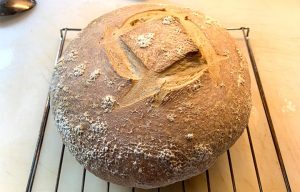 Being stuck at home during a pandemic is a great time to master sourdough bread making. Fresh sourdough not only tastes amazing, but can be very therapeutic to make. One of the main keys to good sourdough is the sourdough starter, this is where the great flavor comes from. There are bakeries and pizzerias that have been using the same sourdough starter for over a century.
Being stuck at home during a pandemic is a great time to master sourdough bread making. Fresh sourdough not only tastes amazing, but can be very therapeutic to make. One of the main keys to good sourdough is the sourdough starter, this is where the great flavor comes from. There are bakeries and pizzerias that have been using the same sourdough starter for over a century.
There are 2 types of sourdough starters, one is made from store bought yeast, the other is made from wild yeast. A starter made from store bought yeast can be ready to use in as little as a few hours. You simply mix warm water with the yeast, wait for it to start bubbling and then mix with flour, a dough ball will form and after it has risen to double its size, it will be ready to use.
A wild yeast starter however can take 5-10 days to ferment before it is ready to use. This is made by combining equal parts flour and water, then allowing this mixture to sit and attract wild yeast, a.k.a., the bacteria that is floating around in the air. This type of starter does need to be “fed” flour and water every day. This fermentation process allows the yeast to feed on the flour while also killing the “bad” bacteria. You can literally watch this process in action, you will see bubbles forming in the mixture and the volume increase. This is not only an amazing process, but it also seems like the best way to make a great tasting local sourdough. Making wild yeast is not quite as simple as it sounds, as I am on my second attempt at a starter approaching week 3 of the process. While I work on my wild yeast starter I have been making sourdough with a starter from the store bought yeast, which is now almost 3 weeks old and is really smelling pungent, a good thing in the world of sourdough starters.
My sourdough recipe is very simple, its a mix of all purpose flour, bread flour, salt, and warm water. Once this is formed into a dough, I fold in an equal amount of sourdough starter, I like my starter to be more of a solid form that I can fold into the dough. Once combined you set this dough into a greased bowl and cover loosely until it doubles in size, approximately 2-3 hours. Next the dough is placed on a lightly floured surface where it can kneaded to squeeze the air out and shape the dough. It is then placed in a towel lined bowl, for a round sourdough loaf, and covered until the dough has proofed, should be double the size and slowly spring back when pressed. After proofing it is ready for the oven.
I started this journey by baking my sourdough on a preheated cast iron pan in a 400 degree oven, since then I have upgraded to a ceramic baking store. The bread is done when the outside has nice hard shell and is brown in color. It can very tempting to slice the bread as soon as it comes out, who doesn’t like hot fresh bread, however the sourdough loaf needs to cool on a rack to finish cooking. I promise if you wait an hour, you can still have warm sourdough.
A good sourdough should have a crunchy crust, an inside with lots of “holes”, bubbles from the yeast, but not so many that it can’t still be sliced and hold a spread, and of course should taste great.

